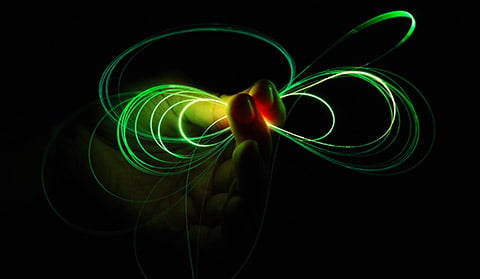The degree to which light can be confined determines the intensity and precision of light-based devices. It also sets the limits within which nanoparticles can be observed.
For these reasons, finding ways to confine and control light in ever smaller volumes is an ongoing challenge for the photonics community.
Scientists from the University of Southampton, in collaboration with colleagues at the Technical University of Dortmund and the University of Regensburg, have demonstrated that a light beam can be confined to a spot that is 50× smaller than its own wavelength. In a first-of-its-kind demonstration, the researchers said, the team further showed that the spot can be moved by miniscule amounts at the point where the light is confined.
“By its nature, light is indeed very difficult to localize on a smaller length scale than its wavelength, a critical threshold known as the Abbe limit,” said research fellow Erika Cortese. “However, using a sophisticated model and numerical simulation, we have successfully demonstrated a novel approach to localize and dynamically manipulate light at a subwavelength scale.”
The Southampton-led team theoretically investigated the multimode coupling between the cyclotron resonances of a 2D electronic gas and highly confined THz-resonator modes, it said. The team reported that it developed a general theory describing multimode coupling in systems of reduced dimensionality, taking into account the non-orthogonality of the electromagnetic modes.

A team of researchers led by the University of Southampton has shown that light can be moved within a distance that is smaller than its own wavelength. The researchers believe that the demonstrated approach for the active control of confined electromagnetic fields could influence multiple nanophotonic applications. Courtesy of the University of Southampton.
“We highlighted specific spectral features due to the presence of multiple photonic modes and demonstrated the possibility to tune the level of intermode coupling by lateral confinement of the 2DEG (2D electronic gas),” the researchers said in their paper.
According to the researchers, the demonstrated effects could make it possible to dynamically tailor the spatial profile of subwavelength electromagnetic modes by varying the applied static magnetic field, and could potentially be used to realize subwavelength optical tweezers to trap and move nanoparticles over submicron distances.
Optical tweezers use highly focused laser beams to trap, manipulate, and move particles with extreme precision. The lenses in standard optical tweezers cannot focus beams on lengths much smaller than the laser beam’s own wavelength, which limits the degree of precision that can be achieved with the tweezers.
Based on the results of their theoretical work, the researchers hope to explore new experimental methods and setups that will allow them to observe the predicted modification of the electric field profiles, driven by the coupling. They also aim to investigate different resonator configurations, to maximize the effects of the multimode hybridization.
Further research could open the way to more advanced manipulation techniques, such as the sorting and rational assembly of nanoparticles for use in biology, chemistry, and soft matter research.
“Looking to the future, in principle, it could lead to the manipulation of micro- and nanometer-size objects, including biological particles — or perhaps the sizeable enhancement of the sensitivity resolution of microscopic sensors,” said professor Simone De Liberato.
Future findings could also lead to new quantum applications based on a controllable and potentially dynamical tuning of highly confined electromagnetic fields.
“We believe our novel approach to actively control confined electromagnetic fields could have high-impact consequences across multiple nanophotonic applications,” De Liberato said.
The research was published in Optica (www.doi.org/10.1364/OPTICA.473085).
*This article has been updated to reflect an initial error in titling.